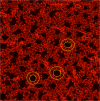Self-organizing pattern of subpleural alveolar ducts
- PMID: 32081933
- PMCID: PMC7035422
- DOI: 10.1038/s41598-020-59752-3
Self-organizing pattern of subpleural alveolar ducts
Abstract
In this study we have utilized an optical clearing method to allow visualization of a heretofore undescribed subpleural acinar structural organization in the mammalian lung. The clearing method enables visualization of the lung structure deep below the visceral pleura in intact inflated lungs. In addition to confirming previous observations that the immediate subpleural alveoli are uniform in appearance, we document for the first time that the subpleural lung parenchyma is much more uniformly organized than the internal parenchyma. Specifically, we report that below the surface layer of alveoli, there is a striking parallel arrangement of alveolar ducts that all run perpendicular to the visceral pleural surface. A three dimensional visualization of alveolar ducts allowed for a calculation of the average inner to outer duct diameter ratio of 0.53 in these subpleural ducts. This unique, self-organizing parallel duct structure likely impacts both elastic recoil and the transmission of tethering forces in healthy and diseased lungs.
Conflict of interest statement
The authors declare no competing interests.
Figures





References
Publication types
MeSH terms
Grants and funding
LinkOut - more resources
Full Text Sources

